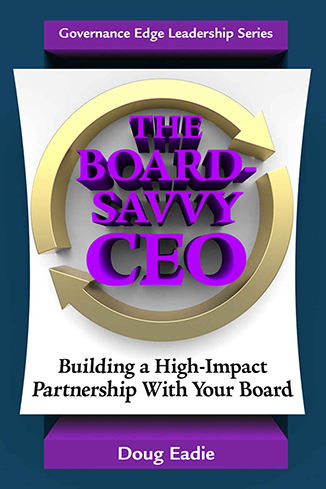 As I noted in the July 25 post at this blog, turning nonprofit boards into really cohesive governing teams is no piece of cake, primarily because of the diverse agendas and differing levels of governing knowledge and experience board members bring to the boardroom. No matter how stiff the challenge, however, board-savvy nonprofit CEOs know that they’ve got no choice but to help their boards become more effective governing teams for two main reasons. First, teamwork is one of the preeminent keys to making high-impact governing decisions. And, second, the satisfaction that doing really high-impact governing work generates makes board members more reliable partners for the CEO. Board-savvy nonprofit CEOs are well aware that frustrated, dissatisfied board members make for fair-weather partners whose support tends to evaporate when the inevitable you-know-what eventually hits the fan.
As I noted in the July 25 post at this blog, turning nonprofit boards into really cohesive governing teams is no piece of cake, primarily because of the diverse agendas and differing levels of governing knowledge and experience board members bring to the boardroom. No matter how stiff the challenge, however, board-savvy nonprofit CEOs know that they’ve got no choice but to help their boards become more effective governing teams for two main reasons. First, teamwork is one of the preeminent keys to making high-impact governing decisions. And, second, the satisfaction that doing really high-impact governing work generates makes board members more reliable partners for the CEO. Board-savvy nonprofit CEOs are well aware that frustrated, dissatisfied board members make for fair-weather partners whose support tends to evaporate when the inevitable you-know-what eventually hits the fan.
The July 25 post took a look at one important tool for transforming your board into a more cohesive governing team: involving board members in shaping a detailed “board governing mission” that lays out the board’s ultimate governing goals and outcomes. This post describes two other team-building strategies: developing guidelines governing board members’ interaction with each other; and strengthening board members’ emotional ties.
Many nonprofits have found that putting together a set of simple, straightforward guidelines to govern board member interactions is an effective, inexpensive tool for strengthening board teamwork. A common approach is to develop the initial set of guidelines in a retreat setting, and after they have been refined and adopted, to update them every year or so. One nonprofit’s guidelines included, for example: “open, honest, frequent communication;” “respect for each other’s viewpoints and opinions;” “no hidden agendas;” “support for the majority’s decisions even if you disagree;” and “adherence to the formal governing structure and process established by the board.”
Guidelines aren’t worth the paper they’re written on unless your board pays attention to their observance. In this regard, many nonprofit boards have assigned their board operations (or governance) committee responsibility for monitoring adherence to the guidelines.
Strangers don’t make good team members, and building greater intimacy among your board members is a proven way to grease the interaction wheels and help your board get through traumatic situations largely unscathed. Building emotional ties among nonprofit board members is a real challenge because of the limited amount of direct interaction, but many nonprofits have successfully narrowed the distance among board members by taking such simple steps as:
- Asking every board member to supply a detailed biographical sketch, covering both professional and personal details, and putting the sketches together in a handbook distributed to all board members
- Adding informal social interaction to regular board business meetings, for example, over lunch or dinner and at such special events as an evening river cruise or attendance at a sporting event
- Holding an annual one or two-day retreat away from headquarters, with considerable breakout-group work built in as a means to foster active interactionAnd employing standing committees of the board as means for strengthening interaction through small-group work involving less formality than full board meetings





